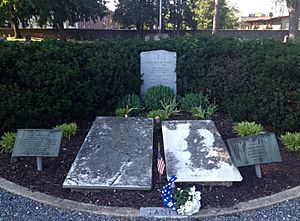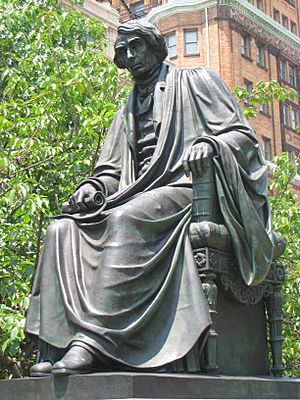Roger B. Taney facts for kids
Quick facts for kids
Roger B. Taney
|
|
|---|---|
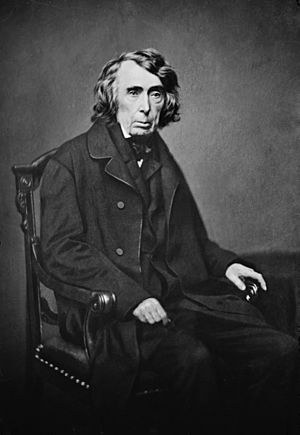
Portrait by Mathew Brady, 1855–1860
|
|
| 5th Chief Justice of the United States | |
| In office March 28, 1836 – October 12, 1864 |
|
| Nominated by | Andrew Jackson |
| Preceded by | John Marshall |
| Succeeded by | Salmon P. Chase |
| 12th United States Secretary of the Treasury | |
| In office September 23, 1833 – June 25, 1834 |
|
| President | Andrew Jackson |
| Preceded by | William Duane |
| Succeeded by | Levi Woodbury |
| 11th United States Attorney General | |
| In office July 20, 1831 – November 14, 1833 |
|
| President | Andrew Jackson |
| Preceded by | John Berrien |
| Succeeded by | Benjamin Butler |
| Acting United States Secretary of War | |
| In office June 18, 1831 – August 1, 1831 |
|
| President | Andrew Jackson |
| Preceded by | John Eaton |
| Succeeded by | Lewis Cass |
| Attorney General of Maryland | |
| In office September 1827 – June 18, 1831 |
|
| Governor |
|
| Preceded by | Thomas Kell |
| Succeeded by | Josiah Bayly |
| Member of the Maryland House of Delegates from Calvert County |
|
| In office 1799 |
|
| Personal details | |
| Born |
Roger Brooke Taney
March 17, 1777 Calvert County, Maryland, U.S. |
| Died | October 12, 1864 (aged 87) Washington, D.C., U.S. |
| Political party |
|
| Spouse |
Anne Key
(m. 1806; died 1855) |
| Children | 6 |
| Education | Dickinson College (BA) |
| Signature | |
Roger Brooke Taney (March 17, 1777 – October 12, 1864) was an important American lawyer and judge. He served as the fifth Chief Justice of the United States from 1836 until his death in 1864.
Taney is most known for his ruling in the Dred Scott v. Sandford case in 1857. In this case, he decided that African Americans could not be U.S. citizens. He also ruled that Congress could not stop slavery in U.S. territories. Before becoming Chief Justice, Taney worked for President Andrew Jackson as the United States Attorney General and United States Secretary of the Treasury. He was the first Catholic person to serve on the Supreme Court.
Taney was born into a wealthy family in Maryland that owned slaves. He was first elected to the Maryland House of Delegates as a member of the Federalist Party. Later, he disagreed with his party about the War of 1812. He then joined the Democratic-Republican Party and was elected to the Maryland Senate in 1816. He became a well-known lawyer in Maryland and was appointed as the Attorney General of Maryland in 1827.
Taney supported Andrew Jackson's campaigns for president. He became a member of Jackson's Democratic Party. In 1831, President Jackson made Taney his attorney general. Taney became a key member of Jackson's team and played a big part in the "Bank War." From 1833, Taney was the secretary of the treasury, but the United States Senate did not approve his appointment.
In 1835, after the Democrats gained control of the Senate, Jackson nominated Taney to be Chief Justice. He took over from John Marshall. Taney's court focused more on states' rights. However, the Taney Court did not limit federal power as much as some people feared. By the 1850s, he was respected, and some leaders hoped the Supreme Court would settle the debate over slavery.
Even though Taney had freed his own slaves and gave money to older ones who couldn't work, he supported slavery. He was upset by people in the North who attacked slavery. He hoped his Dred Scott decision would end the slavery debate forever. But his ruling made many Northerners angry and made the anti-slavery Republican Party stronger. Their candidate, Abraham Lincoln, won the 1860 presidential election.
After Lincoln was elected, Taney felt sympathy for the Southern states that left the Union. He blamed Lincoln for the American Civil War. Taney disagreed strongly with President Lincoln's use of executive power during the war. In a case called Ex parte Merryman, Taney ruled that the president could not stop the writ of habeas corpus. Lincoln did not follow this ruling. Taney died in 1864. At that time, many people in the North disliked him. Lincoln did not make a public statement about his death. Taney's Dred Scott ruling is still seen as one of the worst Supreme Court decisions ever made.
Contents
Early Life and Education
Roger Brooke Taney was born in Calvert County, Maryland, on March 17, 1777. His parents were Michael Taney V and Monica Brooke Taney. His family had come from England in 1660 and became wealthy Catholic landowners. They ran a successful tobacco farm using slave labor.
Since Roger's older brother was set to inherit the family farm, his father encouraged Roger to study law. At age fifteen, Taney went to Dickinson College. There, he studied subjects like ethics, logic, and languages. After graduating in 1796, he studied law with Judge Jeremiah Townley Chase in Annapolis, Maryland. Taney became a lawyer in Maryland in 1799.
Family Life
Taney married Anne Phoebe Charlton Key on January 7, 1806. Anne was the sister of Francis Scott Key, who wrote "The Star-Spangled Banner." Roger and Anne had six daughters. Even though Taney was Catholic, his daughters were raised in Anne's Episcopal Church.
During his time working for the federal government, Taney rented an apartment. But he and his wife kept their main home in Baltimore. After Anne died in 1855, Taney and two of his unmarried daughters moved to Washington, D.C. permanently.
Early Political Career
After becoming a lawyer, Taney started a successful law practice in Frederick, Maryland. His father encouraged him to run for the Maryland House of Delegates as a Federalist Party member. Taney won his first election but lost his bid for a second term.
Taney remained a Federalist for several years. However, he left the party because he supported the War of 1812. In 1816, he was elected to the Maryland State Senate for a five-year term. In 1823, Taney moved his law practice to Baltimore. There, he became known as a very good lawyer.
In 1827, Taney was appointed as the Attorney General of Maryland. Taney supported Andrew Jackson in the presidential elections of 1824 and 1828. He joined Jackson's Democratic Party and helped lead Jackson's campaign in Maryland in 1828.
Taney thought slavery was wrong. He freed the slaves he inherited from his father early in his life. He also gave monthly payments to the older ones who could not work. However, he believed that slavery should be ended slowly and mainly by the states where it existed. He also blamed people who wanted to abolish slavery for "ripping the country apart."
In 1819, Taney defended a Methodist minister named Jacob Gruber. Gruber had been arrested for speaking out against slavery. Taney argued that Gruber had a right to freedom of speech. Taney gave a strong defense of Gruber, calling slavery "a blot on our national character." The jury agreed and found Gruber not guilty.
Working for President Jackson
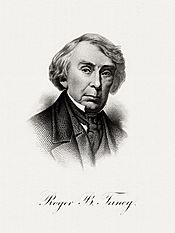
Cabinet Member
In 1831, President Jackson asked most of his cabinet members to resign. He then asked Taney to become his United States Attorney General. Taney became Jackson's main legal advisor. In one of his opinions, Taney wrote that the U.S. Constitution did not protect the rights of free Black people. This was an issue he would address again later.
Taney became a key player in the "Bank War." This was President Jackson's fight against the Second Bank of the United States, which was a national bank. Taney believed the national bank was against the Constitution. He thought Jackson should try to get rid of it. With Taney's support, Jackson vetoed a bill that would have kept the national bank open. The Bank War became the main issue of the 1832 United States presidential election. Jackson won the election, defeating Henry Clay, who supported the national bank.
After winning re-election, Jackson continued the Bank War. When the Secretary of the Treasury, William J. Duane, refused to move federal money out of the national bank, Jackson fired him. Jackson then made Taney the Secretary of the Treasury. Taney moved federal money from the national bank to state banks, which were called "pet banks." In June 1834, the Senate rejected Taney's appointment as Secretary of the Treasury. This left Taney without a job in the cabinet. He was the first person nominated to a cabinet position to be rejected by the Senate.
Supreme Court Appointment
Even though the Senate had rejected Taney before, Jackson nominated him again in January 1835. This time, he was nominated to be an Associate Justice on the Supreme Court. However, those who opposed Taney made sure the Senate did not vote on his nomination before the session ended.
But the Democrats gained more seats in the Senate in the 1834 and 1835 elections. In July 1835, Jackson nominated Taney to become Chief Justice after John Marshall died. Despite efforts by the Whig Party to stop him, Taney was confirmed in March 1836. He was the first Catholic to serve on the Supreme Court.
The Taney Court
John Marshall had led the Supreme Court for 35 years. His rulings, like in Marbury v. Madison, had made the federal courts a strong part of the government. Many Whigs worried that Taney would change the Court's direction too much. Even though Taney's court focused more on states' rights, it did not weaken federal power as much as some people feared.
Important Cases (1836–1844)
One of the first major cases for the Taney Court was Charles River Bridge v. Warren Bridge. In this case, the owners of an older bridge argued they had a monopoly. But the state of Massachusetts had allowed a new bridge to be built nearby. Taney ruled that the original charter did not give the first bridge a monopoly. He said that the Court would interpret contracts narrowly if they conflicted with the public good. This ruling helped allow for new infrastructure projects.
In Mayor of the City of New York v. Miln (1837), the Court looked at a New York law. This law required ship captains to report information about their passengers. The question was whether this law interfered with Congress's power to regulate trade. The Court ruled that the law was a police measure, meaning it was within the state's power to protect its people.
Another important case was Briscoe v. Commonwealth Bank of Kentucky (1837). This case dealt with state banks. The Constitution says states cannot issue "bills of credit." The Court decided that notes issued by a state-chartered bank were not "bills of credit" if the bank, not the state itself, was responsible for redeeming them. This decision supported state control over banking.
In Bank of Augusta v. Earle (1839), Taney ruled that corporations from one state could do business in another state. This was allowed as long as the second state did not have a law specifically stopping them.
The Taney Court also heard Prigg v. Pennsylvania (1842). This case was about slavery and states' rights. The Court ruled that states could not stop federal laws about runaway slaves. Taney believed that states had a duty to help enforce these laws.
The Court also heard the case of the Amistad slaves. These slaves had taken control of a Spanish ship. The Court ruled that they were free men and had the right to defend themselves. Taney agreed with this decision.
Important Cases (1845–1856)
In the 1847 License Cases, Taney developed the idea of "police power." He explained that states have the power to govern people and things within their borders. This broad idea helped justify states taking on new duties, like building roads and establishing public schools.
Taney's ruling in Luther v. Borden (1849) was important for limiting the power of federal courts. The Court decided it would not rule on matters that were considered "political questions." This showed that the Court would sometimes limit its own power.
Genesee Chief v. Fitzhugh (1852) was about shipping accidents on large bodies of water. In England, admiralty law (law of the sea) only applied to waters affected by tides. But in the U.S., there are huge lakes and rivers that are not tidal but are used by large ships. Taney ruled that admiralty law should apply to any waters that are actually navigable, regardless of tides. This greatly expanded federal court power over waterways.
During the 1850s, the U.S. became more divided over slavery. In Strader v. Graham (1851), the Court ruled that slaves from Kentucky who had performed in the free state of Ohio remained slaves because they had returned to Kentucky voluntarily. This ruling avoided a major split on the Court, but debates over slavery continued to divide the nation.
The Dred Scott Decision
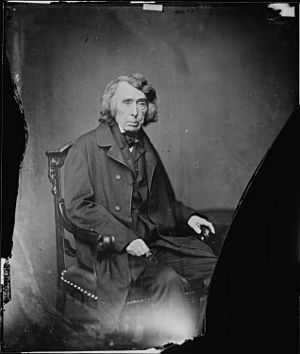
Since Congress could not solve the debate over slavery, some leaders hoped the Supreme Court could. In 1856, the case of Dred Scott v. Sandford reached the Supreme Court. Dred Scott was an enslaved African-American man in Missouri. He sued for his freedom, arguing he had become free after living with a previous owner in a free state (Illinois) and a territory where slavery was banned by the Missouri Compromise.
In February 1857, most of the judges first voted to deny Scott his freedom simply because he had returned to Missouri. However, Taney and his four Southern colleagues decided to make a much broader ruling. They wanted to stop federal regulation of slavery in the territories. Taney and others hoped the Dred Scott case would end the national debate over slavery forever.
On March 6, 1857, Taney delivered the Court's main opinion. First, he stated that no African American, whether free or enslaved, had ever been a citizen under the Constitution. He claimed that for more than a century, Black people were seen as "inferior" and had "no rights which the white man was bound to respect." He pointed to state laws to support this, but he ignored that some states had allowed Black people to vote in 1788.
Next, Taney declared that the Missouri Compromise was unconstitutional. He said the Constitution did not give Congress the power to ban slavery in the territories. Taney argued that the federal government was like a "trustee" for the people in the territory. Therefore, it could not take away the right of slave owners to bring slaves into the territories. He said only the states could ban slavery. Finally, he ruled that Scott remained a slave.
The Dred Scott decision was strongly criticized in the North. Associate Justice Benjamin Robbins Curtis resigned from the Court because of it. Instead of ending the slavery debate, the ruling made the anti-slavery Republican Party more popular. Republicans like Abraham Lincoln disagreed with Taney's legal reasoning. They argued that the Declaration of Independence showed that the Founding Fathers wanted to protect the rights of all free men, no matter their race. Many Republicans accused Taney of being part of a plan to make slavery legal everywhere in the U.S.
The Civil War Years
Abraham Lincoln won the 1860 presidential election. In response, several Southern states left the Union and formed the Confederate States of America. The American Civil War began in April 1861. Taney's home state of Maryland stayed in the Union, and he did not resign from the Court. However, he believed the Southern states had the right to leave. He also blamed Lincoln for starting the war.
From his position on the Court, Taney challenged Lincoln's broad use of presidential power during the Civil War. He did not get to rule on the constitutionality of the Emancipation Proclamation or other wartime laws. But he did preside over two important Civil War cases.
After people who supported the South destroyed bridges and telegraph lines in Maryland, Lincoln stopped the writ of habeas corpus in much of the state. This allowed military officials to arrest people suspected of supporting the South without a trial. After a riot in Baltimore, Union officials arrested state legislator John Merryman. They suspected him of destroying Union property.
In his role as head of the federal circuit court for Maryland, Taney heard the case of Ex parte Merryman. Taney ruled that only Congress had the power to stop habeas corpus. He ordered Merryman's release. Lincoln did not follow Taney's order. Lincoln argued that the Constitution did give the president the power to suspend habeas corpus in emergencies. Later, when Lincoln suspended habeas corpus on a larger scale, he asked Congress to approve it, which they did in 1863.
In 1863, the Supreme Court heard the Prize Cases. These cases were about Union ships seizing other ships that were trading with the Confederacy. If the Supreme Court had ruled against the Union, it would have been a big blow to Lincoln's war efforts. The Court's majority opinion upheld the seizures. It ruled that the president had the power to create a blockade without Congress declaring war. Taney disagreed with this. He joined a dissenting opinion that argued Lincoln had gone too far by ordering a blockade without Congress's approval.
Death
Taney died on October 12, 1864, at age 87. This was the same day his home state of Maryland passed a law ending slavery. He had served as Chief Justice for 28 years, making him the second longest-serving Chief Justice. He was also the oldest Chief Justice ever. Taney had sworn in seven different presidents.
President Lincoln did not make a public statement about Taney's death. Lincoln and three of his cabinet members attended Taney's memorial service in Washington. Only one cabinet member went to Taney's funeral and burial in Frederick, Maryland. After Lincoln was re-elected, he appointed Salmon P. Chase, an anti-slavery Republican, to replace Taney.
Legacy
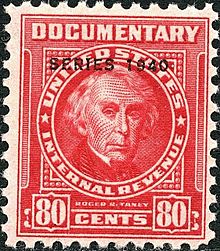
Historical Reputation
After his death, Taney remained a controversial figure. Many Northerners felt that the Dred Scott decision made them lose respect for him.
Historians often link Taney's place in history to his "disastrous Dred Scott opinion." Some scholars argue that this decision made him abandon his usual careful approach to legal problems. However, other scholars note that Taney had many achievements on the Court. They say he was second only to John Marshall in building the foundation of American constitutional law.
Memorials
Taney's home, Taney Place, in Calvert County, Maryland, was added to the National Register of Historic Places in 1972. Another property linked to Taney, called the Roger Brooke Taney House, is in Frederick, Maryland.
Several places and things were named after Taney, including Taney County, Missouri, and a U.S. Coast Guard ship, the USCGC Taney (WPG-37).
Removal of Memorials Due to Dred Scott
In 1993, the Roger B. Taney Middle School in Temple Hills, Maryland, was renamed for Justice Thurgood Marshall. Marshall was the Supreme Court's first African American justice.
A statue of Taney used to stand on the grounds of the Maryland State House. But the state of Maryland removed the statue in 2017. This happened two days after the mayor of Baltimore ordered the removal of a similar statue in Baltimore City.
In 2020, during the George Floyd protests, the U.S. House of Representatives voted to remove a bust (a sculpture of his head and shoulders) of Taney from the U.S. Capitol. They wanted to replace it with a bust of Justice Thurgood Marshall. The bust had been in the Old Supreme Court Chamber in the Capitol Building. On February 9, 2023, the bust of Roger Taney was officially removed from the U.S. Capitol Building. It will be replaced by a new artwork honoring Justice Thurgood Marshall.
See also
 In Spanish: Roger B. Taney para niños
In Spanish: Roger B. Taney para niños
- Demographics of the Supreme Court of the United States
- Dual federalism
- List of justices of the Supreme Court of the United States
- Origins of the American Civil War
- United States Supreme Court cases during the Taney Court


